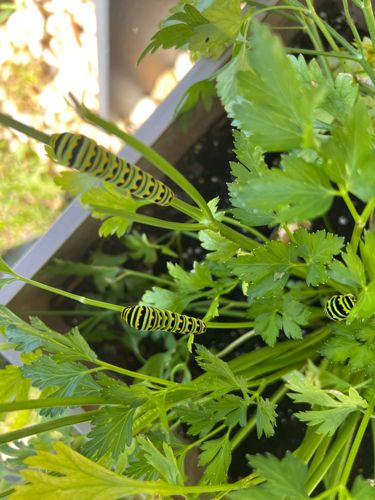Black Swallowtail Caterpillar (also known as Parsleyworm)
Scientific Name: Papilio polyxenes
Order & Family: Lepidoptera, Papilionidae
Size: Larvae (caterpillars) typically grow up to 5-6 cm (2-2.5 inches) in length.

Natural Habitat
Gardens, meadows, fields, and other open areas where their host plants (Apiaceae family) are found. They are commonly found on plants such as parsley, dill, fennel, and carrots.
Diet & Feeding
The caterpillars are herbivorous, feeding exclusively on the leaves of host plants, especially those in the Apiaceae (carrot or parsley) family. Adult butterflies feed on nectar from various flowers.
Behavior Patterns
Young caterpillars are spiky and dark, often resembling bird droppings for camouflage. As they mature, they become smooth with distinct black and green stripes, and yellow spots. When disturbed, they can extend an orange, foul-smelling organ called an osmeterium from behind their head as a defense mechanism. They are solitary feeders. They will eventually pupate into a chrysalis, which can be green or brown to blend with surroundings, before emerging as a Black Swallowtail butterfly.
Risks & Benefits
Risks: Caterpillars can defoliate host plants, which can be a nuisance for gardeners growing parsley, dill, or other related herbs. Benefits: The adult Black Swallowtail butterflies are important pollinators. The caterpillars themselves are an interesting part of garden biodiversity and life cycle observation for enthusiasts.
Identified on: 9/8/2025